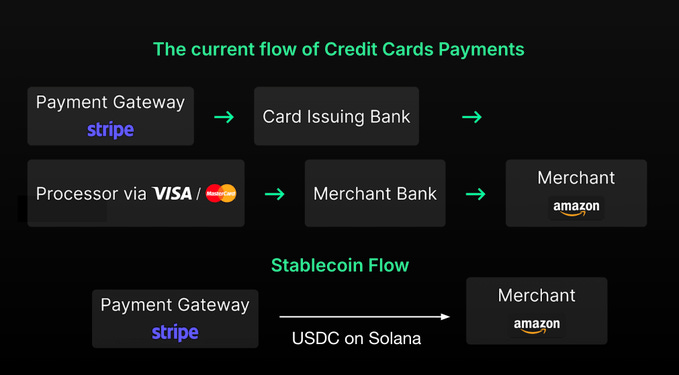Bridging the Gap: How Stripe’s $1.1B Acquisition of Bridge is Changing the Stablecoin Game
Signaling Stripe’s deep conviction in the future of stablecoins and the critical infrastructure behind them.
Introduction
Stripe’s $1.1 billion acquisition of Bridge has quickly become the largest crypto-related deal in history, but it's not just the price tag that’s turning heads. This move places Stripe at the center of the stablecoin and blockchain conversation, positioning it to play a leading role in the evolving world of digital payments. While the acquisition raises questions—particularly around the valuation—it signals Stripe’s deep conviction in the future of stablecoins and the critical infrastructure behind them.
So, why exactly did Stripe pay over five times Bridge’s previous valuation? It’s a calculated move that speaks to Stripe’s broader strategy and where it believes the value in stablecoins truly lies.
Why Stripe Made the Move: Accelerating Crypto Payments Infrastructure
Bridge might not have had the same name recognition as some of its larger counterparts, but it was quickly establishing itself as a vital player in stablecoin payments. Founded by fintech veterans, Bridge developed software that helps businesses accept, transfer, and manage stablecoin transactions seamlessly. The company wasn’t about issuing stablecoins—it was about making them functional for real-world businesses.
Bridge’s orchestration layer, which enables the smooth transfer of value between different stablecoins and fiat currencies, became an attractive asset for Stripe. Rather than spend years building this technology from the ground up, Stripe opted to buy a fully developed, compliant platform that could integrate directly into its global payments system. This acquisition buys Stripe immediate access to technology and market reach that would otherwise take considerable time and resources to replicate.
What’s more, Bridge’s ability to solve practical problems—like reducing cross-border transaction costs—has allowed it to prove the utility of stablecoins beyond speculative trading. Governments, corporations, and fintech companies alike have tapped Bridge’s APIs to streamline international payments, showing that stablecoins can deliver real economic value.
For Stripe, the acquisition is a way to position itself at the forefront of digital payments infrastructure, especially as more businesses begin to realize the benefits of stablecoins for things like remittances and treasury operations.
Stablecoins: From Crypto Buzzword to Payment Powerhouse
The rise of stablecoins has transformed them from a buzzword into a fundamental part of global finance. Originally created to solve the volatility issue in crypto markets, stablecoins have now found their footing as a practical solution for cross-border transactions, especially in markets with unreliable banking infrastructure. By maintaining a stable value, typically pegged to fiat currencies like the U.S. dollar, stablecoins offer the benefits of digital assets—speed and low cost—without the wild price fluctuations of cryptocurrencies like Bitcoin.
Bridge was one of the early companies to recognize the potential of stablecoins as a new form of global money. Its software allows businesses to accept stablecoin payments and seamlessly integrate them into existing financial operations. This evolution from a speculative tool to a business-ready asset was a significant draw for Stripe, which saw an opportunity to bring stablecoins into its already sprawling payments network.
This acquisition reflects Stripe’s belief in stablecoins not as a crypto experiment, but as a solution to some of the most persistent challenges in the financial system—namely, the high costs and inefficiencies of international payments. By adding Bridge’s capabilities to its platform, Stripe can provide its clients with the option to use stablecoins for faster, cheaper global payments, without needing to rely on the slow, costly traditional banking system.
The Infrastructure Bet: Where Stripe Sees the Value
In acquiring Bridge, Stripe is making a bet not just on stablecoins themselves but on the infrastructure that makes these digital currencies usable for businesses and consumers. While companies like Tether and Circle have focused on issuing stablecoins, Bridge took a different approach—building the rails that allow stablecoins to move smoothly between different networks, currencies, and financial institutions.
This orchestration layer is critical because it solves one of the biggest pain points for businesses looking to integrate stablecoins into their operations: converting between fiat currencies and stablecoins without needing to navigate complex blockchain processes. Stripe isn’t just buying Bridge’s revenue streams—it’s buying a shortcut to owning the infrastructure that could drive the future of global payments.
For companies like Stripe, this infrastructure layer may prove to be where the real long-term value lies. While the issuance of stablecoins is competitive—with players like Visa and PayPal entering the fray—the ability to convert, move, and integrate these stablecoins seamlessly into financial systems will be where Stripe stands out. By acquiring Bridge, Stripe ensures it has control over these critical capabilities.
The M&A Implications: What This Deal Means for Crypto
Stripe’s acquisition of Bridge is likely to kick off a resurgence in fintech and crypto M&A. One key takeaway is that it highlights an exit strategy that has been largely overlooked in recent years—acquisitions. For a while, launching tokens and conducting ICOs or other token-based fundraising methods were the preferred exit routes for founders and early investors in the crypto space. However, as regulatory pressure and market volatility have made token releases riskier, acquisitions offer a more stable, less contentious exit.
Bridge’s founders and investors didn’t need to navigate the complex and sometimes risky waters of launching a token to deliver value or exit profitably. Instead, they built valuable infrastructure and found a traditional financial player willing to acquire them. This acquisition shows that M&A, a common exit path in traditional sectors, is not just viable but may become increasingly attractive for crypto companies—particularly those that offer real-world solutions with lasting utility.
While M&A activity has been relatively low in both the general and crypto markets over the past few years, Stripe’s move could reignite interest in this “buy and build” strategy. With Stripe leading the way, more legacy financial institutions may follow suit, seeking to acquire the technology and talent that crypto startups have developed, rather than starting from scratch or navigating the often turbulent token markets. The stability and liquidity provided by an acquisition offer an alternative path for founders and investors who may prefer a more predictable and immediate payout than a token launch can provide.
Additionally, with interest rates expected to drop, large companies will find it easier to finance acquisitions, making this an even more attractive option for early-stage crypto startups. As the lines between traditional finance and blockchain blur, expect more well-capitalized financial institutions to seek out acquisition targets in the crypto space, looking to gain a foothold in blockchain technology through M&A rather than building their own solutions.
Looking Ahead: A New Era of Stablecoins and Payments
Stripe’s acquisition of Bridge represents a pivotal moment for both stablecoins and the broader crypto world. As Bitcoin nears all-time highs and interest rates are expected to fall, this deal couldn’t come at a better time. Lower borrowing costs will likely fuel more M&A activity, particularly as traditional financial companies look to acquire their way into the crypto space.
This deal also highlights a shift in how companies are approaching crypto. Rather than focus on issuing their own tokens, firms like Stripe are opting to buy the infrastructure that makes stablecoins usable in the real world. This focus on usability and integration signals that the next phase of crypto adoption will be driven by companies that can make digital currencies work seamlessly within global financial systems.
For Stripe, this acquisition is a bold move that positions it at the heart of the future of payments. And as more companies follow suit, we’re likely to see a wave of deals that further integrate stablecoins into mainstream finance. The next few years could see a significant reshaping of the payments landscape, with companies that control the infrastructure standing to gain the most.
Conclusion: The Payments Revolution Is Just Beginning
With this acquisition, Stripe has made it clear that the future of payments is digital—and stablecoins will play a central role. Bridge’s technology gives Stripe the infrastructure needed to lead in this space, allowing it to offer faster, cheaper global payments using stablecoins. As more businesses adopt these digital currencies, the need for robust, reliable infrastructure will only grow, and Stripe is positioning itself as the go-to platform for this new era of payments.
As Bitcoin flirts with all-time highs and interest rates are expected to drop, the future looks bright for both stablecoins and the broader crypto market. This acquisition could very well be the first domino in a wave of M&A that reshapes the fintech landscape. The only question now is: who’s next?
Resources:
https://x.com/zcabrams/status/1848391342524641533
https://x.com/zcabrams/status/1848391342524641533
https://x.com/Stablecoin/status/1848390039975469094
https://x.com/yashhsm/status/1848711568659190047
https://x.com/futurenomics/status/1848394371709931728







